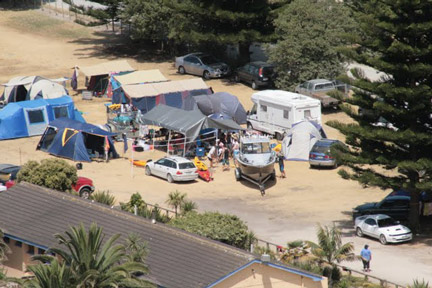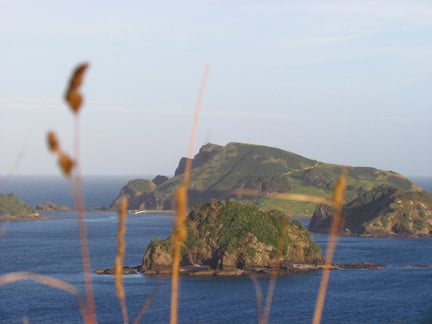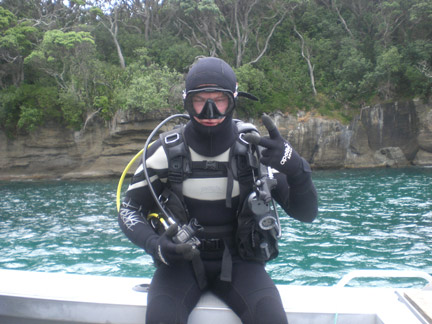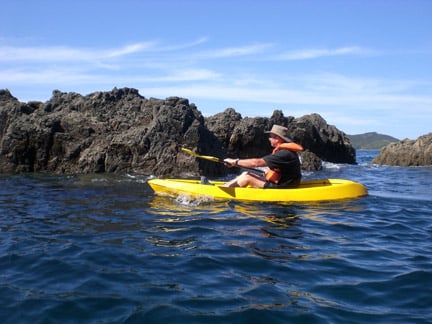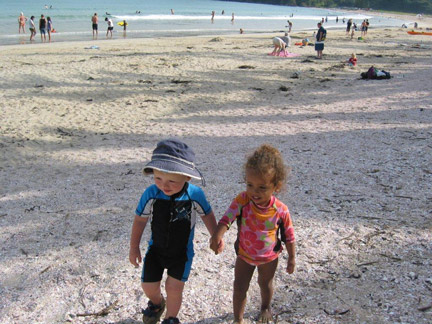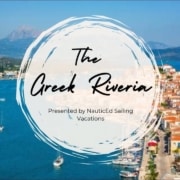Oh – I Do Love to be Beside the Seaside
It’s an old song but it certainly rang the bells for me recently. Over this last New Year’s break 2010-2011, my family, extended family, and friends that we call family all traveled to Matauri Bay in New Zealand for probably one of the best aquatic experiences one could imagine. Unfortunately, it was sans sailing cruising but sometimes it’s good to see the other side of the ocean (meaning other than sailing).
Here is the list of aquatic/camping toys we took
- 6.7 m Surtees aluminum fishing/diving boat
- 5 m wakeboarding/party jet boat
- 6 sets of scuba gear
- 10 fishing rods and reels
- 2 lobster snare hooks
- 3 windsurfers
- 4 sea kayaks
- 2 skim boards
- 3 surfboards
- 5 boogie boards
- 1 performance jet ski
- An uncountable amount of tents
- A huge marquee tent
- 5 sun umbrellas
- Probably 2 liters of sunscreen
- 2 barbecues
and…
- 23 dozen eggs.
The result, as with all vacations, was achieving absolutely nothing except good times.
Matauri Bay is about a 4-hour drive north of Auckland. The bay is about 1 km wide with a beautiful sandy beach. A 250 m high upside-down bowl-shaped headland sits at one end and the top of that provides a commanding view out of the Cavalli Islands 1 km offshore. You can also see 30 km south of the famous Bay of Islands.
The Cavalli Islands provide an abundance of sea life and spectacular anchorage bays. The water temperature at this time of the year is 20 degrees C (68 degrees F). In fact, the entire Coastline is pretty impressive with high rocky cliffs leading down to beautiful bay after beautiful bay.
If you ever think about sailing in New Zealand, spend the almost required 4-5 days exploring the incredible Bay of Islands, but do not miss the Cavalli Islands and then venture slightly further north to Whangaparoa Harbour, a remote harbor with bush right down to the shoreline. If you’re not thinking about sailing in New Zealand – you should start. One of our Sailing Charter business friends here in the Bay of Islands is Sailing New Zealand, give them a call or contact me and I’ll hook you up.
Scuba: We scuba dived so much that on one particular day, I actually turned it down and opted for a day on the beach. We dived mostly for New Zealand Lobster which is referred to as Crayfish. The New Zealand Crayfish has no pincers unlike the lobster most people in the USA think of, but they do have a very spiny crustacean shell which makes it necessary to use a dive glove to capture them. One variety called the Pack Horse Cray can get pretty big.
Matauri Bay is also the sunken location of the famous Green Peace protest boat, the Rainbow Warrior. Its wreck was moved here after being initially attacked and sunk by the French Secret Service in 1985 in the Auckland habour. And so we were able to dive into this wreck situated in 23 m of water. The sea has taken pretty good hold of it now and it thus inhabits a really great display of reef life. There are a few places for advanced divers to swim through the wreck and whilst it’s very ominous to swim through a sunken ship it is a fun thing to do to see the fish attending school inside the hull.
A memorial to the Rainbow Warrior and its crew Member who died in the attack is erected atop the Matauri Bay headland.
Thanks go to Craig Johnston who saved my dive. We showed up at the dive site in our 6.7 m dive boat, suited up (5mil wet suit required preferably with a hood), almost ready to tip over backward into the water when I discovered that I’d left my mask behind. Although air is pretty important down there – a mask is probably the next most important. Craig was the Dive Master on the Paihia Dive boat that tied up to us. Paihia Dive is a professional dive company that takes tourist divers out to the Rainbow Warrior and Matauri Bay area for a 2 tank dive. Embarrassingly, I called over to their group and pleaded for a temporary borrow of a spare mask and offered up a bag of Salt and Vinegar chips as compensation. Graciously Craig accepted the highly unfair trade. Thanks, Craig – the dive was great. Hope you enjoyed our chips.
Fishing and Sea Life: It’s hard to put a hook on the bottom in New Zealand with out catching something. In the north, it’s mostly snapper and thus the 12 days were mostly spent eating superbly fresh snapper although we did hook (and eat) quite a few other varieties.
All in all we sampled 11 different sea garden foods, including, lobster, local abalonie (called Paua), scallops, and fish fish fish.
At Matauri Bay you launch your boat off the beach – there is no ramp. Dean is the local tractor driver and for $20 he’ll expertly launch and retrieve your boat. I say expertly because sometimes the waves can be a little challenging and an expert tractor driver can save you from a lot of damage should a wave come in at the wrong time.
Windsurfing: It’s been a while since I’ve windsurfed but now from this trip, I figure it’s time to get back into it. I used to be pretty good about 10 years ago. My 15 year old niece, Steff, wins local competitions and so we went out on a couple of windy days together. I got a few good rides on one particular day when the wind was blowing 30 knots. I chickened out when I ventured out further and started getting into a 2 meter swell. Although I could handle it fine the small voice of caution was speaking PRETTY LOUDLY.
The principle of windsurfing is pretty cool. Once you start to understand sailing and forces it doesn’t take too much to figure it out or get back into it. Raking the mast forward moves the center of pressure of the sail forward and thus positions the force on the board more forward causing the board to turn downwind. Conversely, raking the mast backward turns the board towards the wind. The raking movement is done with your hand closest to the mast. Your aft hand works the sail like a mainsheet, pulling the sail to the center line on upwind runs or letting out on downwind runs. It acts like an accelerator and helps with your balance.
Steff showed me some technological advances in windsurfing equipment. She told me that tightening up the downhaul made the top of the sail twist out. Wow, I had to think about that for a sec. Turns out it’s pretty easy to understand and is the same principle that I wrote a blog on a few months back. On a flexible mast, tightening the downhaul puts a significant bend in the mast. This bends the tip of the mast down closer to the aft of the boom and thus reduces leech (aft part of the sail) tension on the sail. New windsurfing sails have a large roach in the sail, ie the line from the head (top of the sail) to the clew (back bottom of the sail) is not straight but curves out significantly. Thus reduced leech tension allows the curve of the sail to twist out under wind force. In my previous blog, the same twist out on a large sailboat is achieved by releasing the main sheet but bringing the traveler to windward. In both cases you are effectively reducing the size of the sail and more importantly forces aloft on the rig. It’s cool to know that once you understand the principles you can just figure it all out from there.
Skimboarding: I doubt there are very many people at my age hydroplaning on a skimboard in the 1 cm wash of the beach waves but anyway I gave it a pretty good go without busting a hip. My 11-year-old nephew, Rafi, mastered it quite well and was doing 180’s by the time we left.
Surfing: I’m not a surfer. Give me a sail. But my 60-year-old brother-in-law rode the 1.5m waves on several days and showed up everyone on the beach.
Jet Skiing: OMG – this jet ski was a high-performance version built for time trials and wow it could accelerate faster than you could hold on almost. The requirement to make the tight turns at speed makes it very unstable to sit on. In deep water, it’s very difficult to climb onboard. One day, it was hosing down with rain and so we figured that the only thing to do on a wet rainy day was to get wet in a big big way. The jet ski was the answer – that was fun.
Sea Kayaking: The rocky coastline around the headland and further up the coast provides a most awesome sea kayaking location. The surge from the swell washes water through cracks between close-to-shore rocks and reefs. Running the kayak through these is pretty exciting at times. But you also can see into the water and watch the kelp below flow side to side with the occasional fish venturing along. Seagulls protecting their young dive from the rocks above.
We paddled quite a way up the coast to a house set slightly back from the beach – but there was no road into the house – just a very basic farm track. This brings up another point – I just can’t think of any other place in the world where you have working farms that go right down to the shore in such a high percentage of coastline than New Zealand. This little (beautiful) house was just sitting there in the most gorgeous bay with a backdrop of a green grass valley 100 feet from a deserted beach and an ocean loaded with sea life. Wow!
The Beach: Great place for the kids to play. My Daughter and (great) Nephew had the best time of their lives.
Whales: I left the highlight for the end. We were blessed with 2 visits from a pod of Orca Whales.
On one occasion they were swimming all around us on the boat when we were returning from a scuba dive on my birthday. On another, they came right onto the beach next to us. My sister and I promptly jumped in the sea kayaks to go for a visit. They were breaching all around our kayaks so close that we were getting wet from their blowholes. Although seemingly slightly scary because they have big teeth, our Captain Nemo friend Alex (who we are sure has gills on the sides of his neck, assured us that Orcas in the wild have never eaten anyone. Despite this – my heart raced a bit when one breached about 5 feet away from my kayak.
So that’s what one can do in 12 days in paradise with a big family and lots of toys. Now it’s back to work with NauticEd – we’ve got some exciting advances coming this year. Right now we’re working on a referral program to be launched in the next few days and a Skipper test out exam for advanced sailors. Beyond that, we’ll launch more courses this year including a sailing race regatta course. Some large companies are approaching us for alliances and … whew it’s exciting being at the forefront of technology, and education and wrapping it up with something we love – SAILING. I hope you all can take advantage of everything that we offer and get your sailing certificate!
TTYL
Grant
PS – if you’ve ever been to Matauri Bay – add your comment below.


